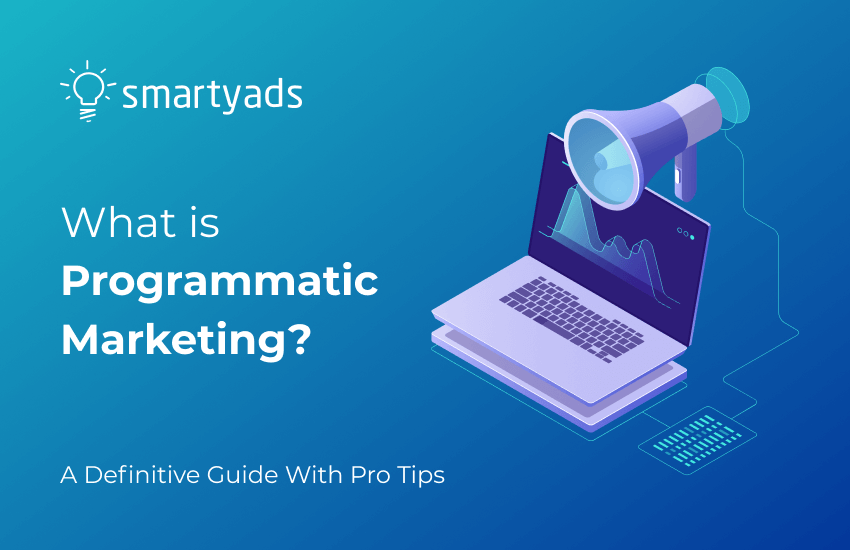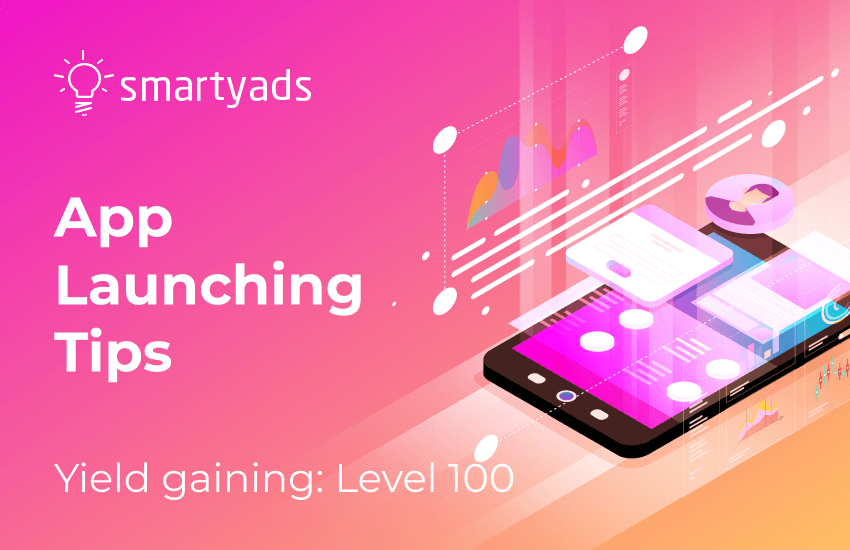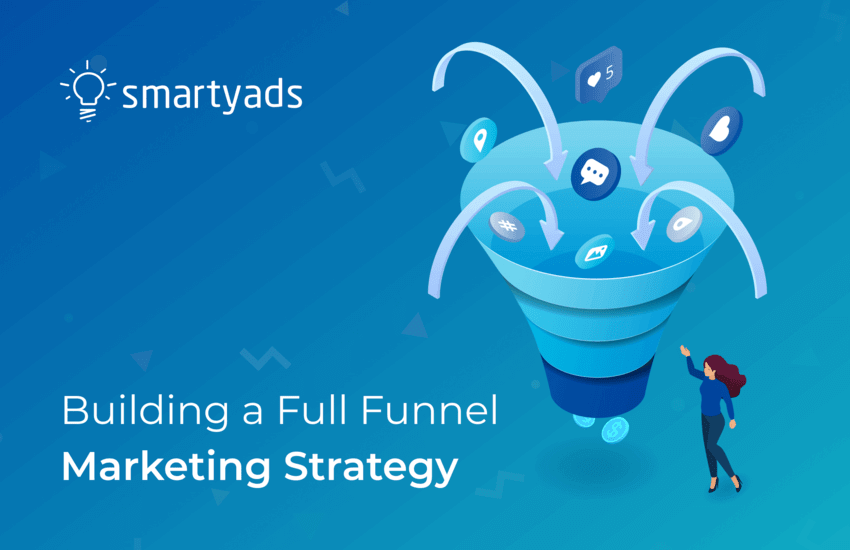Nowadays, it is hard to imagine a world of online advertising without programmatic marketing. Once programmatic advertising technology entered the industry, the landscape shifted towards automation and real-time trading so the whole process became more effective.
To use this mechanism efficiently, it is not enough to have only tools and solutions. The key element here is knowledge. One should understand what is programmatic marketing, how it works, and, most importantly, how to use it in accordance with business needs and goals. In this article, we are going to answer these questions and explore what are the most important advantages of programmatic advertising.

What is programmatic marketing?
Our initial point is programmatic marketing definition, as a clear understanding of this term will serve as a ground for our further analysis and exploration.
So, what is the definition of programmatic marketing?
In simple terms, programmatic digital marketing or programmatic advertising includes a range of technological solutions that enable the real-time digital advertising trading process. Instead of sending numerous proposals and spending hours negotiating, marketers can now focus on ads improvement and targeting. With programmatic advertising, digital ads are purchased with machines and algorithms, while humans focus their work on planning and optimization of their advertising.
There are numerous benefits of programmatic advertising, such as:
- More precise metrics and targeting;
- Transparent pricing;
- Cost-efficiency;
- Automation.
Programmatic advertising technology automates the media-trading process with real-time bidding RTB algorithms and helps to achieve higher profits for both advertisers and publishers, providing them with automated media selling/media ad buying solutions. The usage of programmatic ad has been rising steadily and this trend doesn’t seem to be slowing down - by the end of 2021 programmatic advertising will account for 86% of total digital display advertising spending.
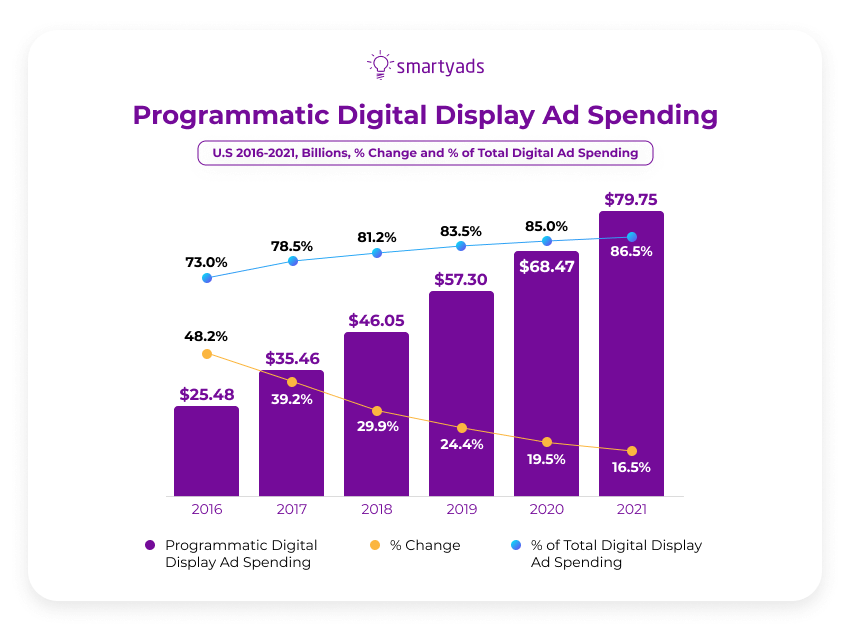
Advantages of programmatic marketing
Using programmatic marketing has a lot of benefits to offer to both advertisers and publishers from automation of the campaigns to digital advertising on all platforms and channels and digital media at the same time (social media, CTV, mobile, in-app).
Let’s discover how these advantages of programmatic advertising work using real examples.
No need to spend time on manual manipulations
Previously advertisers and digital media buyers had to schedule digital advertising campaigns and buy ad space manually. They used to spend a lot of time searching for the right advertising space, negotiating the price, ad location, and time frame for placement.
In contrast, programmatic advertising is served automatically in real-time, meaning that AI (artificial intelligence) and ML (machine learning) find the best matching ad inventory on behalf of advertisers and serve ads on those placements that fit campaign criteria best.
NB: What is ad inventory? Ad inventory is a certain amount of space that the publisher can allocate for advertising.
You can target local and international audiences
Even small companies can get started with international advertising simply by tapping into programmatic ads. Why? Firstly, because automation decreased the cost of advertising so everyone now can buy ad space.
Secondly, because with precise targeting programmatic ad impressions can be served all across the globe (ad serving is adjusted to the timezones).
While setting marketing programmatic advertising campaigns advertisers can also increase visits to their brick-and-mortar stores. For this purpose, it will be enough to show ads to the users whose geo data shows that they stay nearby (from a few meters to several kilometers from the physical store).
You can place ads across different channels
Like no other technology, using artificial intelligence and machine learning in programmatic advertising allows advertisers to simultaneously run ad campaigns through various digital marketing channels at the same time. Using your campaign data the platform can deliver programmatic ads consistently across display, mobile web, in-app, and CTV ecosystems.
They allow serving ads at those channels that your audience prefers more. For example, channeling ads through mobile and on social media during leisure time) might be the best strategy if your audience consists of Millennials. At the same time, the ad impression can also find a Millennial user during working hours on a PC. Meanwhile, people also watch TV with friends and families so programmatic advertising on Smart TV would help advertisers to address more people and decrease cost per impression.
Additionally, you can choose from the variety of available digital ad formats specifically suited to these channels, including video, native, rich media, banners ads, or else.
You don’t show ads to disinterested users = save ad budgets
Definition of programmatic marketing it is not about advertising at a certain advertising space, it’s about real-time advertising to the right Internet users who have the potential to become customers.
While serving programmatic advertising, the system will match the user data with your campaign criteria to determine if the online ad can be a good fit for you and for the viewer. Thus, the online ad will be served only to those viewers to whom your product or service is relevant.
This way the ad budget won’t be spent on irrelevant impressions - you deliver ads only to people who have high chance to convert.
You can access performance any minute
There is no need to make additional integrations in order to measure up the performance of programmatic advertising - since demand-side platform DSP serves the ad campaigns it also aggregates all necessary data and delivers analytics in real-time.
Demand-side platforms (DSP) also visualize reports to help you understand the dynamics of each metric in particular - ad impressions, the number of clicks those impressions generate, win rates, spend, click-through rates, and many others. It elevates your efforts in programmatic marketing.
Programmatic digital marketing: evolution
Programmatic marketing started with display ads automation powered by real-time bidding RTB in 2012. Around 2012 the first real-time auctions were launched too. Real-time bidding auctions were initially created to trade remnant ad inventory, but things changed when the efficiency of automated trading became obvious, so marketers started to use it for any kind of ad space.
This led to the creation of demand-side platforms (DSPs). In contrast to the marketplace for everyone, these platforms were created specifically for advertisers and were focused on advertising programmatic buying. As the market was growing, the prevalence of programmatic advertising did too. In the following years, private marketplaces were established. It made a shift from remnant supply to premium ad inventory. Programmatic marketing wasn’t a narrow niche anymore and brands just couldn't ignore it.
Within just 3 years, the US programmatic spending of digital display ads leaped from 73% of all display ad spending in 2016 to 87% in 2021. To put it into more practical numbers, in 2016 programmatic ad spending equaled $25.4 billion. By the end of 2021, this number will reach almost $81 billion, (more than 2 times increase). Nowadays, this complicated system of algorithms defines spend of countless brands and is constantly improving. So where does programmatic advertising go now and what can we expect from programmatic marketing?
Current state and the future of programmatic
Programmatic advertising continues to evolve ever since the world realized the advantages of programmatic. The US is leading the race, as its programmatic advertising spend is expected to exceed $80 billion by 2021 which will account for 87.5% of total display ad spend.
The second place is held by China where $16 billion is expected to be spent on programmatic digital marketing by 2021. In the meantime, the EU has also shifted attention to programmatic marketing -- more than 80% of the UK digital ads are traded programmatically. By 2021, the same number will be reached by France, Germany, and Denmark.
What's coming up next then?
The programmatic advertising industry is growing not only in terms of quantity but also in quality. Although artificial intelligence algorithms are already advanced enough to determine, monitor, and improve your ad spend strategy, new trends are emerging to make this process even more profitable and sophisticated.
Traditional manual ad trading is not likely to revive, so it is now a perfect time to learn and integrate programmatic marketing or digital marketing into your business model. To make this process easier and more convenient, let's break it down into a few simple steps.
Where to start with programmatic marketing?
Define your goals
No matter if you are just a beginner who wants to start trading programmatically, first things first - you have to know what you want to achieve with programmatic advertising. It might take some time to grasp lots of new information, but once you’ve got this, it will become so much easier to put your digital marketing knowledge into action. In the case of programmatic marketing, the most important thing is to understand the parties of the trading process, what tools they use and how they interact.
The parties of the media trading in programmatic advertising:
There are two parties involved in the programmatic media buying process - advertisers and publishers (ad buying and selling sides).
Advertisers (demand ) are choosing sites for their ads, providing creatives and executing the programmatic advertising strategies they’ve created.
Publishers, in turn, offer their ad space, provide valuable traffic and collect first-party data about their audience. Both sides are taking part in the process via specific digital marketing platforms that belong to the programmatic ecosystem.
The tools of algorithmic trading that you need to apply:
At first glance, the programmatic advertising ecosystem is huge and complicated, but in reality, things are much simpler once you get to know some terms:
DSP - a demand-side platform DSP is a media buying tool that allows advertisers to buy traffic in real-time. Within the (demand-side platform DSP) dashboard, advertisers can upload creatives, choose pricing models, set ad campaigns’ options, monitor campaign effectiveness, and make necessary adjustments. This programmatic advertising platform is also used to set targeting or retargeting based on the company’s marketing needs.
SSP - a supply-side platform is a software platform designed for publishers who want to automate media-selling. Supply-side platform SSP help advertisers selling ad space to the demand-side in real-time. It helps publishers to find specific buyers for their ad space based on criteria they set, such as price floors or preferable ad formats. Supply-side platforms SSPs accumulate ad inventory from publishers and send bid requests to DSPs (with information about an ad slot and user cookies).
DMP - a data-management platform DMP is a digital marketing platform where user data is accumulated and segmented. The data is then analyzed by advertisers who want to build a programmatic advertising strategy based on the brand's target audiences and their behavior. Data-management platform DMP enriches the targeting of programmatic marketing campaigns by connecting to demand-side platforms DSPs.
What are ad exchanges? Ad exchanges are open marketplaces available for both publishers and advertisers to join, they gather both parties in one place.
How do ad exchanges work? At ad exchanges, advertisers are matched to publishers based on their campaign criteria. Then both parties get the best offers during real-time bidding auctions. Thanks to this system, ad exchanges allow avoiding overpricing of advertising.

How does programmatic marketing work and what to expect from it?
The essence of programmatic marketing work is based on the interaction of those media buying and media selling platforms.
Advertisers sign up at the demand-side platform DSP and set their campaigns’ options and budget, while publishers add their ad inventory to the supply-side platform SSP. Based on campaign settings, targeting segments in the data-management platform DMP, and bid request information, DSP defines the relevance of an impression. If the impression is relevant, demand-side platform DSP bids on it in the auction take place at the ad exchange (ad exchanges are also responsible for maintaining auctions).
The programmatic advertising space buying process starts at the real-time bidding RTB auction. The highest bid wins and the winner’s ad is served to the user. Finally, after the campaign ends, an advertiser measures and analyzes the campaign’s effectiveness and, if necessary, optimizes it on a demand-side platform. Let’s discover how to create your first programmatic marketing campaign.
Set your KPIs
Before jumping into your first programmatic marketing campaign, it is important to consider which goals you are aiming to reach and what are the best channels for doing this. Despite the fact that many consider conversions to be the ultimate goal of programmatic advertising, in reality, programmatic advertising should be used throughout each stage of a customer's journey. Here are some common advertising goals:
Raising brand awareness
These campaigns are aimed at attracting potential customers to the company’s products or services. Their main goal is to drive brand awareness among users that have not yet visited your website but may be potentially interested in what you have to offer. Usually, such programmatic marketing campaigns include attractive creatives and intriguing messages addressed to the target audience segments, based on the analysis of existing customers' behavior.
Their performance of programmatic marketing campaigns is measured by various metrics, such as click-through rate (CTR), cost per action (CPA), and return on investment (ROI). Branding campaigns are usually measured with brand awareness KPI - number of impressions and click-through rates (they are automatically measured by DSP platforms. Using Google Analytics brands also measure the impact of the branding campaign by counting the number of unique website users.
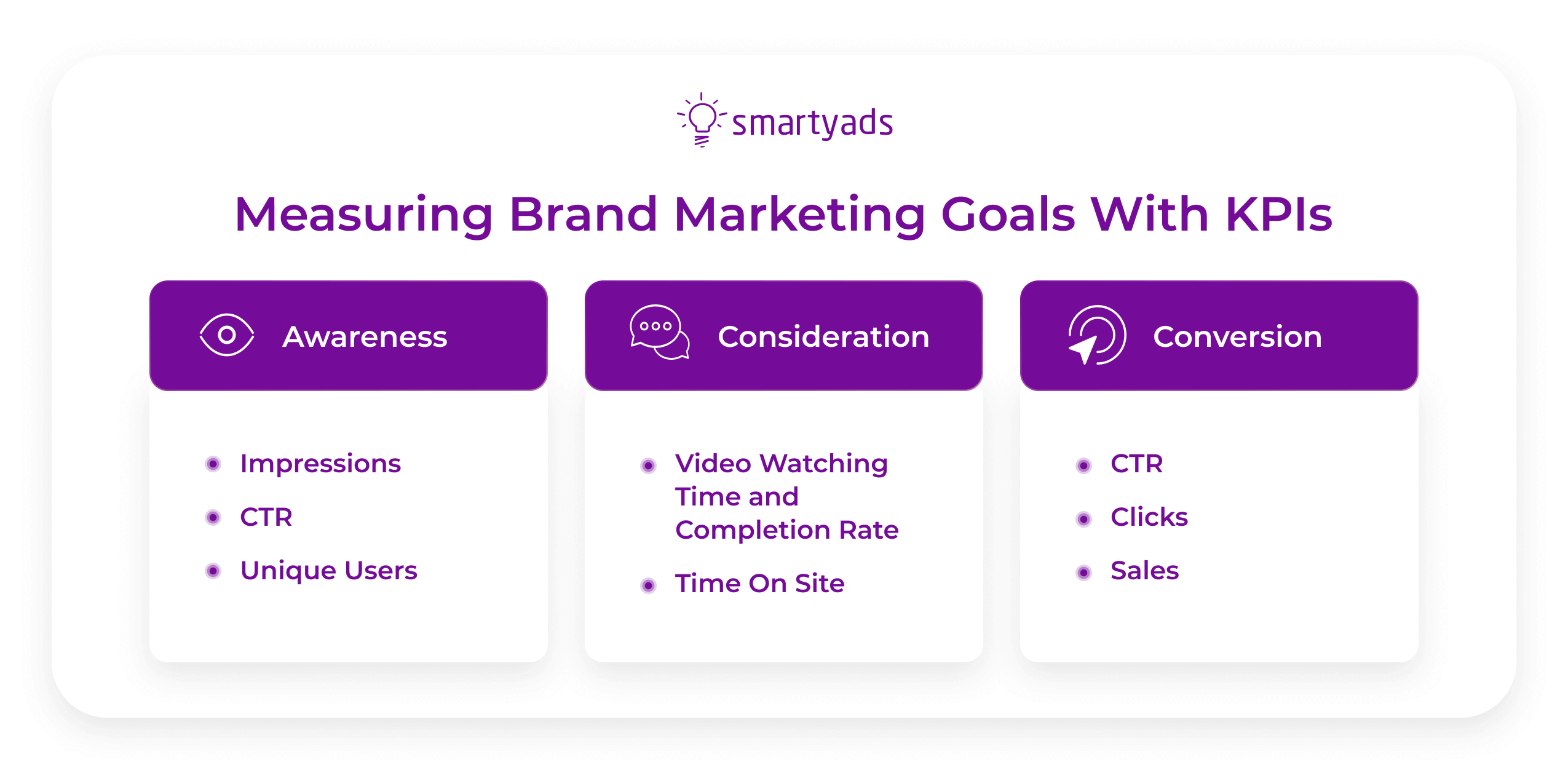
Pro tip: while setting marketing programmatic campaigns make sure that the design of your ads matches the landing page of your site - this will make your brand recognizable from the start of your customer’s journey.
Activating leads
Once your brand is already known and established, it is time to activate your target audience by encouraging them to purchase from you. Make your customers feel welcomed, educate them on your products or services and share useful tips on how to successfully use them.
This type of programmatic advertising will not only spark more interest in your offers but will be useful to your customers which is a very good move to build trust.
This programmatic marketing stage is especially important as it moves your clients to the actual purchase.
Pro tip: pay attention to your calls-to-action - they should highlight the value of your offer.
Retargeting
You probably noticed those visitors who expressed interest in your website, but abandoned their carts. In fact, there is a whole separate type of advertising campaign aimed specifically at returning the users who already visited you, but never took action.
These programmatic advertising campaigns are designed to turn them into buyers by showing them more attractive and relevant ads based on user's behavior, extracted from your first-party data. They are especially useful considering the fact that targeting interested people is more effective than reaching those who haven’t even heard about your brand yet. You can remind your potential customers about your product or service while using retargeting or mobile retargeting campaigns.
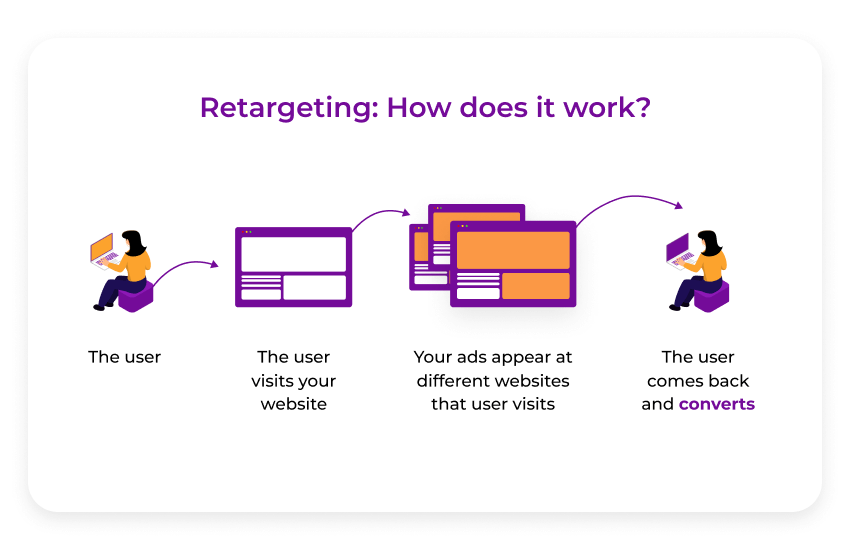
Skillfully arranged retargeting campaigns can awaken lots of dormant customers and improve your ROI dramatically.
Pro tip: make sure your retargeting campaign doesn’t include products already purchased by the customers, as it is often perceived as annoying and might alienate them.
Pick the right channel(s)
Perhaps one of the most important decisions to make is to choose the channel through which you are going to deliver your messages. Due to the recent technological advancements in the industry of programmatic marketing, the number of available programmatic advertising channels has significantly increased. Keep this in mind while elevating your digital marketing and programmatic marketing campaigns.
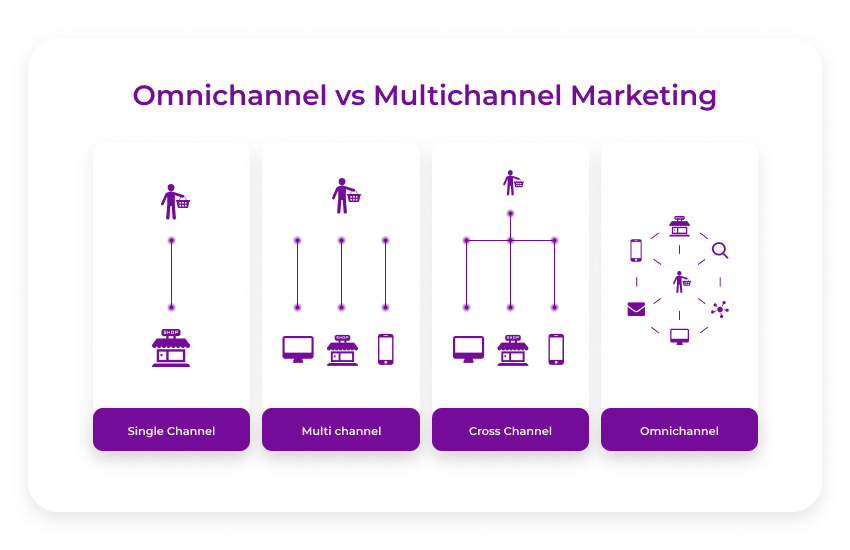
Omnichannel and multichannel ads. The brand received a chance to apply cross-channel, omnichannel and multichannel marketing approaches. The good news is, if your audiences use a wide variety of gadgets, with programmatic advertising you can address customers simultaneously on PC, mobile, CTV, and other channels. This will mean that you apply an omnichannel advertising approach.
Single-channel ads. However, in case you know for sure that your audience consumes content on let’s say mobile (in 70%-90% of cases), single-channel advertising on mobile will guarantee that you effectively invest your budgets. This way you will efficiently advertise without spending advertising budgets on channels that don’t work for you.
If you decided to serve your programmatic marketing ads through a single channel it will be easier for you to select and adapt creatives - they will all belong to let’s say mobile ad formats. On the other hand, for multichannel and omnichannel advertising you can choose from various digital advertising formats - banners, video, and most popular display ones.
Let’s review those most popular formats one by one.
Display advertising (also known as banner advertising) is one of the most popular programmatic advertising formats. This was the first type of ads to appear online and its popularity doesn’t seem to decline any time soon. There are lots of sizes and formats of banner ads, designed for all kinds of messages. Display advertising is very versatile and can be used for almost any campaign, be it brand awareness, leads activation, or retargeting. After the users click on the banner, they get transferred to the landing page or a page with relevant information regarding the advertised brand, product, or service.
Video advertising. Along with the recent technological enhancement of the browsing experience, the quality of video programmatic advertising content rises. Although not new, video advertising gains huge popularity these days, especially after the introduction of 5G networks. Video ad formats are usually divided into in-stream and out-stream ads. In-stream ads are displayed before, within, or after video content, such as Youtube videos or content from streaming services. Out-stream ads include video ads embedded into the website’s content or banners. Video advertising is specifically useful for brand awareness campaigns and reaching new audiences.
Native advertising. Native advertising is one of the most effective as it mimics the environment and content around itself. Programmatic marketing and digital marketing campaigns of any kind can be effective with it. This way ads don't seem annoying to most of the users like certain flashy formats of display advertising. In fact, native advertising is one of the best performing channels with 35% higher CTR, as well as 40% better engagement.
Apart from this, unlike most display advertising formats, native ads are not noticed by adblockers. Paired with the methods of contextual targeting, native programmatic advertising promises to be one of the hottest trends in online advertising in the coming years.
Set up the campaign
Now that you have clearly set your goals and picked the right tools, it is time to set up your programmatic marketing campaign. The process is simple - all you need to do is to sign up at the demand-side platform, fill out the necessary ad campaign settings, and follow several easy steps in order to start bidding.
Choose a type of campaign. Go to the campaigns section and press a button to start a new campaign - choose from the banner, video, or native campaign types. Click next and proceed to campaign settings.
Configure campaign settings. Next in the basic campaign settings, you fill in the campaign name, and domain, and activate the click booster function in order to let the system automatically increase the click-through rates for your ad campaign.
Set up targeting. On SmartyAds DSP you can select up to 30+ targeting options according to which system will serve your ads. The ads can be served according to users Geo, GPS, IAB categories, age range, connection type, browser, language, device type, etc. Note: don’t select too many options as it may narrow your traffic too much.
In the time section, you can also define a suitable time when users should watch your ads (dayparting), and also when to start and end the campaign.
Configure the budget. In the budget section you can set up the total and daily budget limits and the distribution type - evenly or ASAP.
Optimization rules. With this functionality, you can instruct the system on what kind of inventory it should attribute to the blacklists and whitelists. For instance, when the spend, CTR, impressions, and the win rate of a particular source are higher or lower than a certain level the system will put them into the lists you defined. As a result, you will be working with traffic sources more efficiently.
Filter lists and tag tracking. If necessary you can also configure the filter lists and filter traffic according to the bundles, site ID, and the rest of the options. The tracking section also enables advertisers to apply third-party tags for additional tracking possibilities.
Inventory. In the ad inventory section, you can fine-tune the system so that you get requests only from specific supply-side platforms SSPs. As well in this section, you can enter the ID for the direct deals and buy inventory only from specific publishers.
After you’ve filled in all necessary campaign information click next and upload your creative. Shortly after you’ve launched your campaign it will be reviewed by the moderation team, as soon as it is approved your campaign goes live.
Don’t forget to monitor your programmatic advertising campaigns. Timely data analysis and campaign optimization may save you lots of money and bring a lot of new customers in real-time. Apply these 7 ways to optimize campaign performance and check the campaign flow every week or two.
The Takeaway
Programmatic digital marketing may look like a complicated process. Still, there are many benefits of programmatic advertising and the most important of them is that it makes media buying and selling simple and effective.
Start with analyzing your business needs and setting attainable goals. Once you’ve got the vision of what you need - choose the appropriate channels and build your advertising strategy. The final and most important step is to set up a digital marketing campaign - all you need to do is to sign up at a demand-side platform, create your perfect campaign, and let the ad platform do the trading in real-time. Tap into programmatic ad buying today!
Elevate your programmatic marketing campaigns. Get started with SmartyAds DSP!

